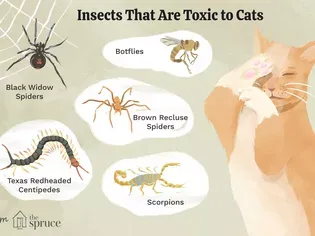Insects That Are Toxic to Cats
Updated on 04/26/24

Insects That Threaten Your Feline's Health: A Comprehensive Guide to Toxic Bugs
As cat owners, we strive to provide a safe and healthy environment for our beloved companions. However, potential hazards lurk even in the most mundane of places, including the insects that may inhabit our homes and gardens. Certain insects pose a serious threat to our furry friends, containing toxins that can cause severe illness or even life-threatening complications.
This comprehensive guide will delve into the world of insects that are toxic to cats, arming you with the knowledge to protect your feline companion from these dangerous pests. We will explore the symptoms, risks, and preventive measures associated with each insect, empowering you to keep your cat healthy and happy.
1. Black Widow Spiders:
* Description: Black widow spiders are easily recognizable by their shiny black bodies and distinctive red hourglass marking on the underside of their abdomen.
* Toxicity: Black widow spider venom is a potent neurotoxin that affects the nervous system, causing muscle spasms, tremors, and severe pain.
* Symptoms: Cats bitten by a black widow spider may exhibit restlessness, lethargy, trembling, and dilated pupils.
* Risks: Black widow spider bites can be fatal if left untreated, particularly in kittens or elderly cats.
2. Brown Recluse Spiders:
* Description: Brown recluse spiders have a distinctive violin-shaped mark on their cephalothorax (head and thorax).
* Toxicity: Brown recluse spider venom contains a cytotoxic agent that destroys skin tissue, causing necrotic lesions.
* Symptoms: Cats bitten by a brown recluse spider may initially experience mild pain, followed by the development of a swollen, discolored area that can progress to a deep ulcer.
* Risks: Brown recluse spider bites can lead to severe skin damage and infection, and in rare cases, systemic complications.
3. Fire Ants:
* Description: Fire ants are small, reddish-brown ants known for their aggressive behavior and painful stings.
* Toxicity: Fire ant venom contains alkaloids that cause intense pain, inflammation, and tissue damage.
* Symptoms: Cats stung by fire ants will exhibit immediate pain and agitation, followed by the development of pustules or blisters at the sting site.
* Risks: Multiple fire ant stings can lead to anaphylaxis, a severe allergic reaction that can be life-threatening.
4. Stinging Caterpillars:
* Description: There are several species of caterpillars that have stinging hairs, including the saddleback caterpillar and the io moth caterpillar.
* Toxicity: The stinging hairs of these caterpillars contain toxins that cause severe skin irritation and inflammation.
* Symptoms: Cats exposed to stinging caterpillars may experience intense pain, redness, swelling, and itching.
* Risks: Severe caterpillar stings can lead to secondary infections or allergic reactions.
5. Cockroaches:
* Description: Cockroaches are common household pests that can carry a variety of pathogens and allergens.
* Toxicity: Cockroaches do not possess venom but can transmit bacteria, viruses, and parasites through their feces and saliva.
* Symptoms: Cats that ingest cockroaches may develop gastroenteritis (vomiting, diarrhea), respiratory problems, or allergic reactions.
* Risks: Cockroach-borne diseases can range from mild to life-threatening.
6. Flies and Maggots:
* Description: Flies and maggots are common pests that can be found in decaying organic matter, such as garbage and animal carcasses.
* Toxicity: Flies and maggots can transmit bacteria and parasites through their bites or by laying eggs in open wounds.
* Symptoms: Cats that ingest flies or maggots may develop gastroenteritis or parasitic infections.
* Risks: Fly and maggot-borne diseases can cause a range of health problems, including skin infections, digestive issues, and respiratory distress.
Prevention:
* Regularly inspect your home and garden for pests: Check for insects and their nests, particularly in areas where your cat spends time.
* Keep your home clean and free of debris: Remove potential breeding grounds for insects, such as garbage and stagnant water.
* Seal cracks and holes: Prevent insects from entering your home by sealing any openings around windows, doors, and foundations.
* Use insect repellents: Apply insect repellents to your cat's fur and bedding, following the instructions carefully.
* Consider natural remedies: Certain plants, such as catnip and pennyroyal, have insect-repellent properties.
Treatment:
If you suspect your cat has been exposed to a toxic insect, immediate medical attention is crucial. Treatment will depend on the type of insect and the severity of the poisoning.
* Antivenom: For bites from venomous spiders, such as black widow spiders, antivenom can be administered to neutralize the toxin.
* Antibiotics: If your cat has ingested or been exposed to insects carrying bacteria or parasites, antibiotics may be prescribed.
* Pain relievers: Pain relievers can help alleviate discomfort caused by insect stings or bites.
* Antihistamines: Antihistamines can reduce allergic reactions to insect bites or stings.
Conclusion:
Understanding the potential dangers posed by toxic insects is essential for safeguarding your cat's health. By being aware of the symptoms and risks associated with these pests, you can take proactive measures to prevent exposure and protect your beloved feline companion from harm. Remember, early detection and treatment are crucial for ensuring your cat's well-being.
Explore More Pets

Cat Behavior Problems
How to Stop Aggression in Kittens

Long-Haired Cat Breeds
Siberian Cat: Breed Profile, Characteristics, & Care

Cat Behavior Problems
How to Stop Kittens From Scratching and Biting

Long-Haired Cat Breeds
Turkish Angora: Cat Breed Profile, Characteristics & Care

Basic Training
How to Socialize Your Kitten

Short-Haired Cat Breeds
Cute Pictures & Facts About Calico Cats & Kittens

Litter Box Training
Training Your Kitten to Use the Litter Box

Long-Haired Cat Breeds
10 Fun Facts About White Cats